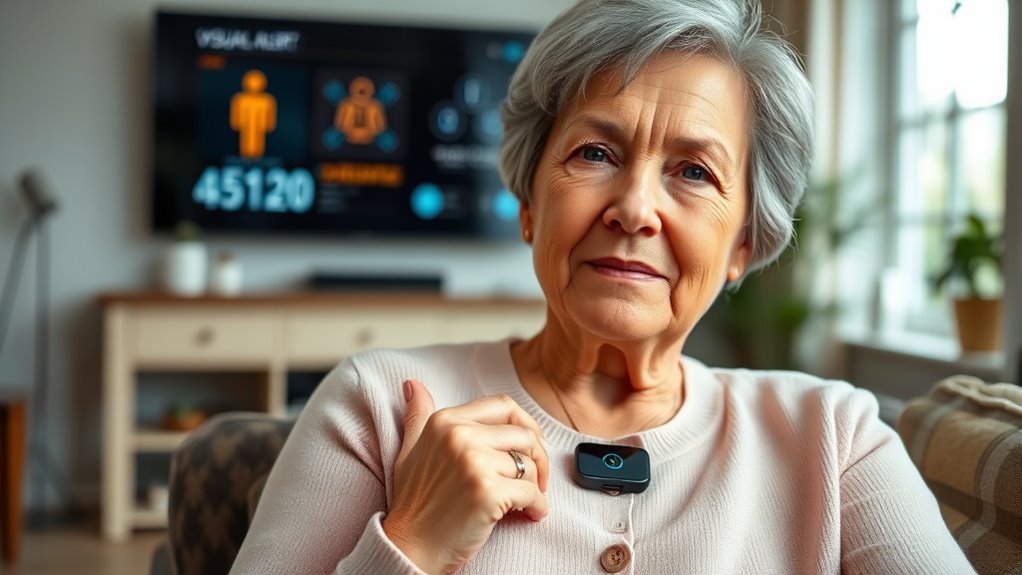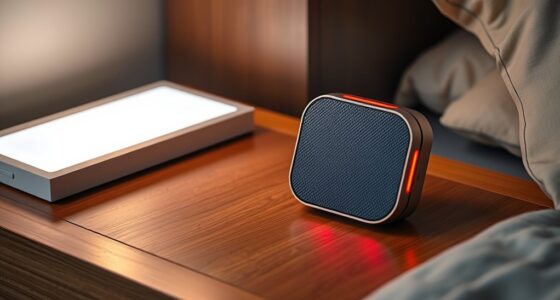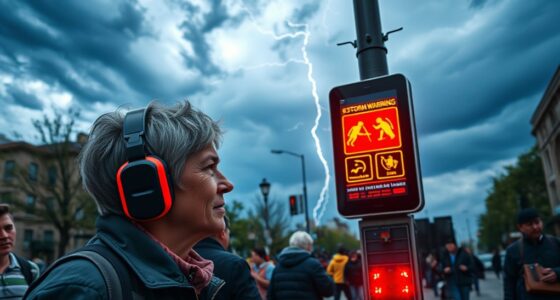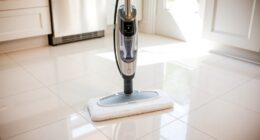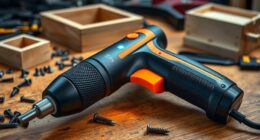If you’re seeking medical alert systems for seniors who are deaf or hard of hearing, you’ll find options that use visual cues like flashing lights, on-screen notifications, and customized colors. Tactile alerts, such as vibrations, provide discreet emergency signals when needed. These systems can often be tailored to your lifestyle and integrated with hearing aids or smart home devices. Exploring these features can help guarantee safety and independence—discover more ways to improve your support and security.
Key Takeaways
- Visual alerts like flashing lights and on-screen notifications ensure deaf and hard-of-hearing seniors receive emergency signals effectively.
- Tactile alerts such as vibrations provide discreet, reliable notifications without relying on sound.
- Customizable alert patterns, brightness, and colors enhance visibility and personalization for individual needs.
- Integration with assistive devices and compatibility with hearing aids prevent interference, improving alert clarity.
- Remote monitoring and smart home connectivity enable quick emergency response tailored to deaf and hard-of-hearing users.
Understanding the Unique Needs of Deaf and Hard-of-Hearing Seniors
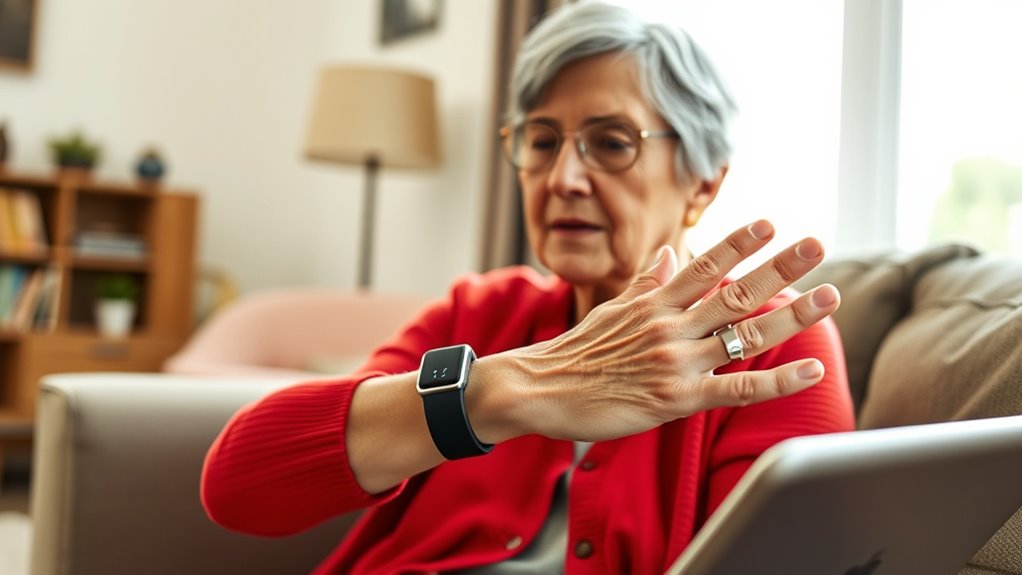
Have you ever wondered how deaf and hard-of-hearing seniors navigate their daily lives? They often rely heavily on assistive communication tools like visual alerts, captioned phones, and sign language devices to stay connected. These tools help them receive essential information quickly and effectively, reducing feelings of isolation. Utilizing wall organization systems and visual cues can also improve their safety and independence within the home environment. Incorporating visual alert systems tailored for hearing-impaired users ensures they are promptly notified of important signals like doorbells, alarms, or phone calls. Emotional support is equally important, as hearing loss can lead to frustration and loneliness. Providing reassurance and understanding helps seniors feel more confident and secure. You can support them by learning their preferred communication methods and encouraging the use of assistive technologies. Recognizing their unique needs enables you to create a safer, more inclusive environment where they can communicate comfortably and maintain their independence. Additionally, understanding hearing loss and its effects can improve your ability to assist and connect with them more empathetically. Recognizing the importance of assistive technology can significantly enhance their quality of life. Moreover, being aware of communication methods can help you better adapt to their needs and foster more effective interactions.
Types of Visual Alert Features in Medical Alert Systems
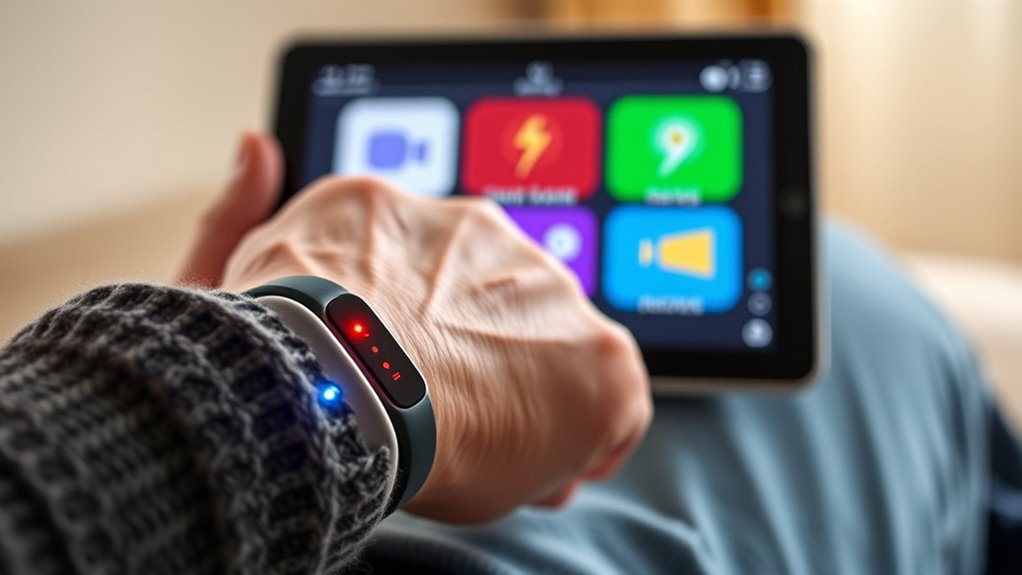
For seniors who are deaf or hard of hearing, visual alert features in medical alert systems play a vital role in ensuring you receive timely notifications during emergencies. These systems offer various visual alert options, such as flashing lights, on-screen notifications, and LED indicators. You can often customize these alerts to match your preferences, enabling better recognition and response.
| Visual Alert Options | Alert Customization | Best Use Cases |
|---|---|---|
| Flashing lights | Brightness levels | Hearing impairment |
| On-screen messages | Color schemes | Visual clarity |
| LED indicators | Sound & light combo | Noisy environments |
With alert customization, you tailor notifications for your needs, ensuring you’re promptly alerted through visual cues.
Vibration and Tactile Alerts as Emergency Notifications
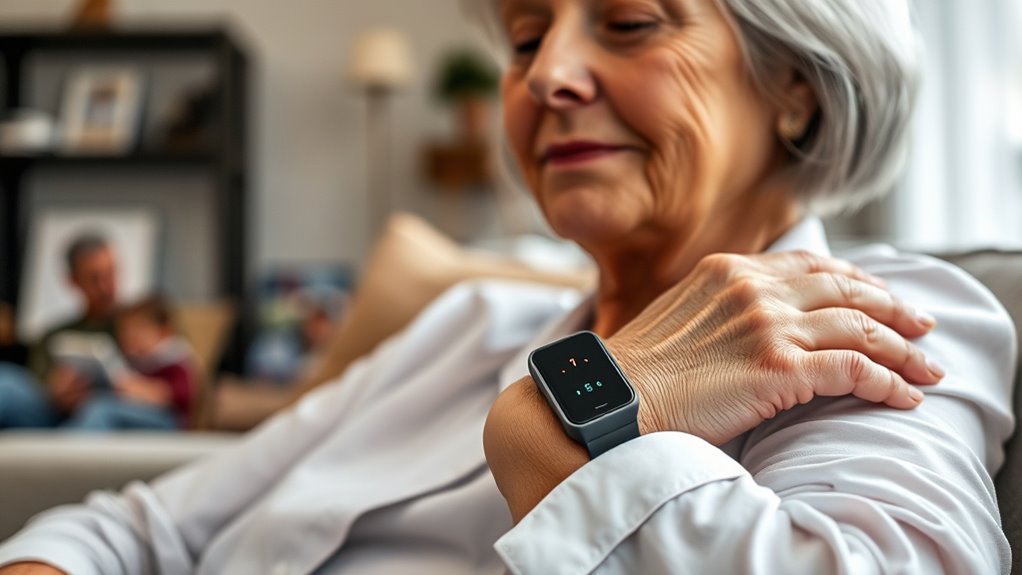
Vibration and tactile alerts can be highly effective in grabbing your attention during emergencies, especially when noise or visual cues aren’t enough. You can customize these alerts to suit your preferences, ensuring you notice urgent notifications promptly. Plus, their seamless integration with emergency systems helps deliver reliable and immediate assistance when you need it most. Incorporating sound design principles can enhance the effectiveness of these tactile signals by optimizing their intensity and pattern for better perception. Additionally, understanding tactile feedback mechanisms can improve the customization and responsiveness of alert devices to meet individual needs. Exploring sensory processing can further help tailor alert systems to maximize responsiveness and clarity. Recognizing the importance of filter replacement indicators can ensure these alert systems remain effective over time, maintaining consistent performance.
Vibrational Signal Effectiveness
Vibrational signals have proven to be highly effective as emergency notifications in medical alert systems for seniors. Their effectiveness depends on tactile feedback accuracy, ensuring the user clearly perceives alerts without ambiguity. Well-designed vibrations can cut through background noise and distractions, providing a reliable cue during emergencies. The strength, duration, and pattern of vibrations play a pivotal role in maximizing vibrational signal effectiveness. When these elements are optimized, seniors are more likely to respond promptly, reducing risks during urgent situations. Additionally, consistent and distinct vibrational patterns help differentiate emergency alerts from routine notifications. Incorporating principles of sound design can further improve the clarity and impact of vibrational alerts. Moreover, understanding the technology behind vibrations allows manufacturers to create more effective alert systems tailored to senior users. For example, advancements in haptic feedback technology enable the delivery of more precise and perceivable alerts. Overall, high tactile feedback accuracy enhances user confidence in the system, ensuring essential alerts are noticed and understood, which is indispensable for the safety and independence of deaf or hard-of-hearing seniors.
Tactile Alert Customization
Customizing tactile alerts guarantees that you receive emergency notifications in a way that’s both noticeable and meaningful. With customizable alert settings, you can select the vibration patterns, intensity, and duration that work best for you. Tactile feedback is essential for ensuring alerts cut through distractions or background noise, especially if you’re deaf or hard of hearing. By adjusting these settings, you create a personalized alert system that effectively grabs your attention when it matters most. Whether you prefer a rapid series of vibrations or a deep, steady pulse, tailored tactile alerts can be more effective than standard signals. Proper storage and maintenance of your alert devices can also help ensure consistent performance over time. Regularly checking and cleaning your devices can prevent malfunction and prolong their lifespan, ensuring reliable emergency notifications when needed. Incorporating adaptive alert customization can further enhance your safety by allowing you to modify alerts as your needs evolve. This personalization is rooted in understanding tactile alert effectiveness, which can vary based on individual sensitivity and preferences. For example, selecting the right vibration intensity can make a significant difference in how well you notice alerts, especially in noisy or busy environments. This customization empowers you to stay safe, confident, and in control of your emergency notifications.
Integration With Emergency Systems
Integrating tactile alerts with emergency systems guarantees that you receive immediate and effective notifications during critical situations. When you activate a silent alarm, the system triggers vibrations or tactile signals to alert you without disturbing others. These vibrations can be paired with visual indicators, such as flashing lights or on-screen alerts, ensuring clear communication regardless of hearing ability. Connecting your medical alert system to local emergency services allows for faster response times, especially if auditory cues aren’t effective. This seamless integration ensures you’re promptly notified of emergencies, whether through vibrations, visual cues, or a combination of both. By leveraging silent alarms and smart home integration, you gain a reliable, discreet way to stay safe and informed in urgent situations. Proper raw food preparation techniques can also be incorporated into your emergency planning, ensuring nutritional needs are met during crises. Additionally, understanding privacy policies related to your alert system can help protect your personal information during emergencies.
Selecting the Right System Based on Lifestyle and Environment
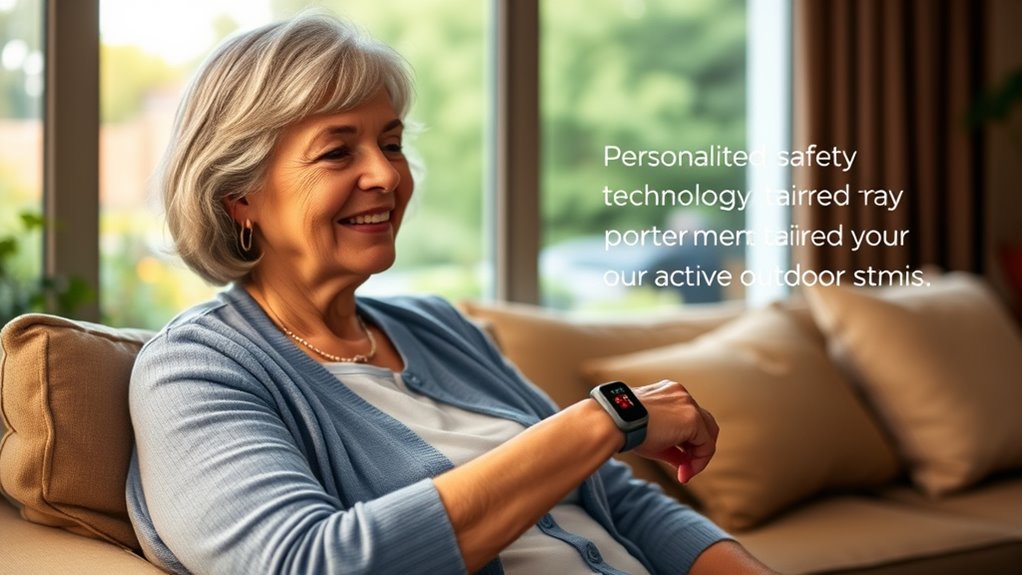
Choosing the right medical alert system depends on your daily routine and environment. If you’re frequently outside or active, a portable device may suit you better, while a home-based system works if you’re mostly indoors. Consider your noise levels and routine to find a system that provides reliable protection without unnecessary disruptions. Additionally, assess how automation in business might influence the availability and features of modern alert systems. Understanding the specific needs of seniors with hearing impairments can help tailor the system to ensure optimal safety and communication. Being aware of hydrogen energy advancements can also inspire innovative solutions for emergency alert technology, promoting safer environments for seniors. Staying informed about AI security vulnerabilities can also help in selecting systems with robust safety features to protect user data and privacy. Moreover, evaluating how retail hours and services are structured can assist in choosing a provider with accessible customer support and timely assistance.
Home vs. On-the-Go
When selecting a medical alert system, your lifestyle and environment play a crucial role in determining the best option. If you spend most of your time at home, a system with large, easy-to-see buttons and a reliable landline connection might suit you best. Wearable devices, like pendants or wristbands, offer convenience and constant access. For active seniors who frequently go out, on-the-go systems with GPS and location tracking are essential. These portable devices ensure help is available wherever you are, providing peace of mind for both you and your loved ones. Consider your daily routines and environment to choose a system that seamlessly fits your lifestyle, offering reliable protection whether you’re inside or venturing outdoors. Additionally, choosing a system that complies with safety standards ensures reliable performance and peace of mind. Incorporating robust sound recording techniques and high-quality equipment can enhance the effectiveness of these systems by ensuring clear and reliable communication in emergencies.
Noise Environment Considerations
Your environment’s noise level can substantially impact how well a medical alert system works for you. Excess background noise and ambient sounds can drown out alerts, especially if the system relies on auditory signals. To guarantee you receive timely alerts, consider your usual noise environment when choosing a system.
- In busy or noisy areas, opt for systems with visual signals like flashing lights or vibrating alerts.
- If ambient sounds are loud, avoid systems that depend solely on sound notifications.
- For quiet environments, standard auditory alerts might suffice, but pairing them with visual cues adds extra security.
Understanding your background noise and ambient sounds helps you select a system that reliably reaches you, no matter your environment. This ensures you won’t miss important alerts due to noise interference.
Lifestyle and Daily Routine
Your daily routine and lifestyle habits play a crucial role in determining the most suitable medical alert system for you. If you frequently forget medical appointments or need medication management, look for systems that offer reminders. Some alert systems integrate with your calendar or send alerts via vibration or visual cues, ensuring you stay on schedule. Consider your environment—if you spend much of your day outdoors or in noisy areas, choose a system with louder alarms or visual signals. If you live alone and are active, portable devices with GPS tracking can provide peace of mind. Matching your lifestyle with a system that offers tailored features ensures you stay connected, safe, and independent, whether it’s managing medication or remembering appointments.
Compatibility With Hearing Aids and Assistive Devices

Ensuring that a medical alert system works seamlessly with hearing aids and assistive devices is crucial for effective use by seniors. You need to verify hearing aid compatibility to prevent interference and ensure clear communication. Many systems support assistive listening devices, making alerts more audible. When choosing a system, consider:
Verify hearing aid compatibility and support for assistive devices to ensure clear alerts and seamless use.
- Compatibility with various hearing aid models
- Support for assistive listening devices
- Ease of use without removing devices
This guarantees you receive alerts without disruption or frustration. A well-integrated system enhances your safety and confidence, especially in emergencies. Confirming these features before purchase guarantees that your alert system complements your existing hearing aids and assistive devices, providing a reliable safety net. Proper compatibility minimizes missed alerts, giving you peace of mind knowing help is always within reach.
Enhancing Safety With Smart Home Integration
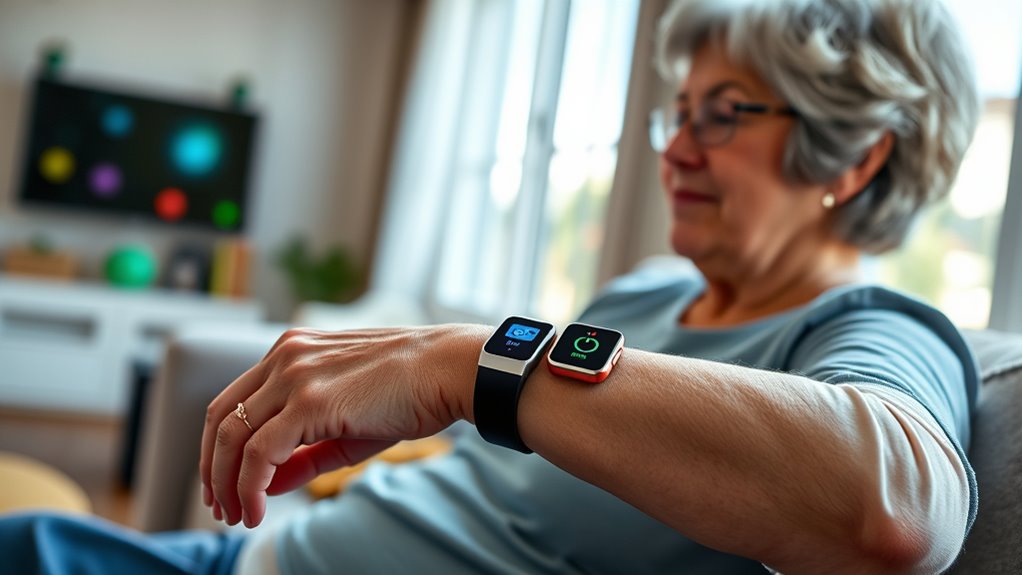
Integrating medical alert systems with smart home technology substantially boosts safety by enabling automated responses and real-time monitoring. Voice recognition allows you to control devices hands-free, making it easier to summon help or adjust settings without needing to reach for a device. With remote monitoring, family members or caregivers can keep an eye on your safety from anywhere, receiving alerts for falls or unusual activity. Smart sensors can detect smoke, carbon monoxide, or water leaks, automatically triggering alerts or safety protocols. This seamless integration creates a more all-encompassing environment, especially for deaf and hard-of-hearing users who rely on visual or alert-based cues. By combining alert systems with smart home features, you get comprehensive protection tailored to your needs.
Training and Support for Effective Use of Alert Systems
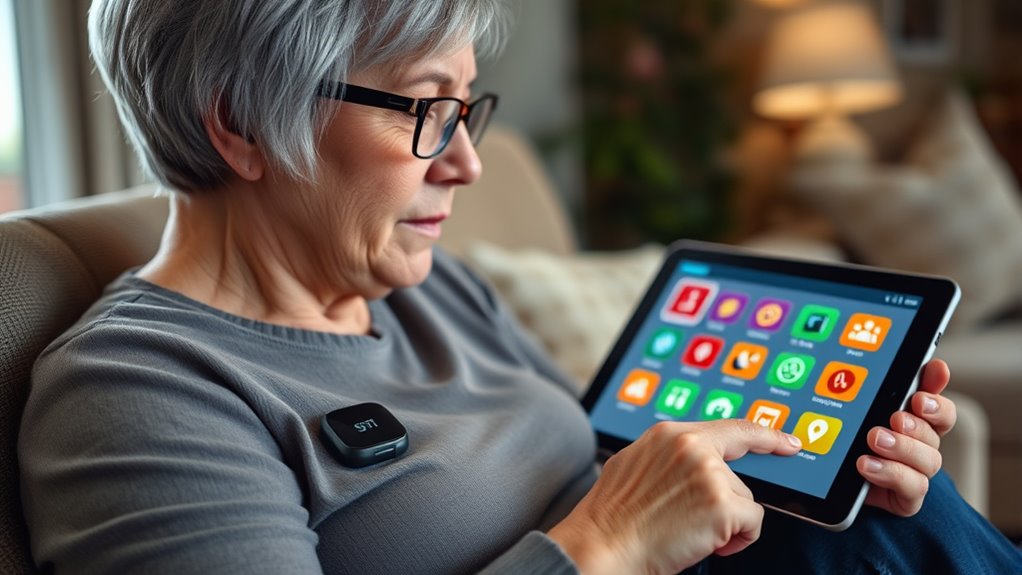
Effective training and ongoing support are essential to guarantee you can use medical alert systems confidently and correctly. Proper instruction helps you understand the user interface, ensuring you can operate the device effortlessly. Regular support also includes guidance on sensor calibration, so alerts remain accurate and reliable. To maximize effectiveness, look for training that covers:
- How to navigate and customize the user interface for quick access
- Proper methods for sensor calibration to prevent false alarms
- Troubleshooting tips to address common issues promptly
These elements empower you to use your alert system independently and with confidence. Remember, ongoing support ensures you stay comfortable with the technology as updates or changes occur, maintaining your safety and peace of mind.
Future Innovations in Emergency Alert Technologies for Hearing-Impaired Seniors
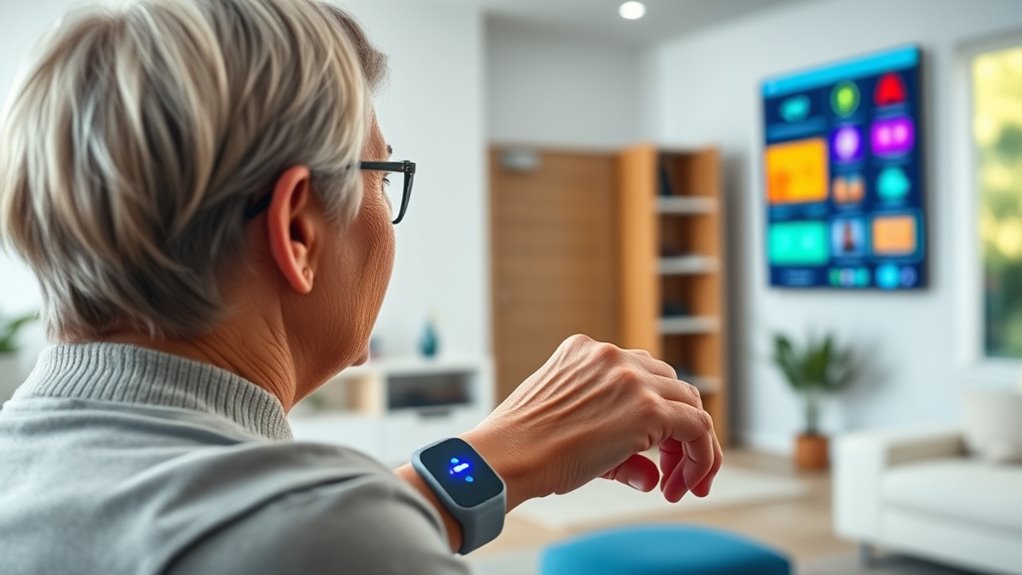
Advancements in emergency alert technologies are opening new doors for hearing-impaired seniors, making safety systems more accessible and reliable. Gesture recognition is transforming how you can activate alerts, allowing you to simply wave or signal to trigger an alarm without needing a traditional device. Remote monitoring is also evolving, enabling caregivers and family members to track your safety in real-time through connected devices. Future innovations may include wearable sensors that detect falls or health issues instantly, alerting both you and your support network. These technologies aim to minimize delays and improve responsiveness during emergencies. As these innovations develop, you’ll benefit from more seamless, intuitive safety solutions tailored to your needs, ensuring you stay connected and protected at all times.
Frequently Asked Questions
How Long Do the Batteries Last in Visual Alert Systems?
Battery longevity in visual alert systems varies depending on the device and usage. Typically, batteries last between several days to a few weeks, but regular device maintenance is key to guaranteeing peak performance. You should check the manufacturer’s guidelines, replace batteries as recommended, and keep the device clean. Staying on top of battery life helps you avoid unexpected power loss and ensures your alert system remains reliable when you need it most.
Are There Any Legal Regulations for Medical Alert Systems for Seniors?
When considering legal regulations for medical alert systems, you should know that regulatory compliance is vital. Laws vary by region, but generally, systems must meet privacy standards to protect your personal information. You need to confirm the device you’re using adheres to these regulations, providing safety and privacy. Always check if the alert system complies with local laws to guarantee it’s safe, reliable, and respects your privacy rights.
Can These Systems Be Used Outdoors or in Extreme Weather?
You might wonder if these systems work outdoors or in extreme weather. Many are designed with weather durability, so they withstand rain, snow, and heat. Look for models with outdoor connectivity features, ensuring your device stays connected even in challenging conditions. However, always check the manufacturer’s specifications to confirm the system’s durability and connectivity range, giving you peace of mind that it’ll perform reliably in any weather or outdoor setting.
How Discreet Are Vibration and Tactile Alert Devices?
Imagine a gentle tap on your wrist, almost like a heartbeat, that quietly alerts you without drawing attention. Vibration and tactile alert devices feature a discreet design, blending seamlessly with everyday wear, ensuring user privacy. You won’t feel bulky or obvious. These subtle cues keep you informed while maintaining your dignity, letting you focus on what matters most without worry about others noticing your alert.
What Is the Average Cost of Comprehensive Alert System Setups?
You’ll find that extensive alert system setups typically range from $200 to $500, depending on features and installation costs. Cost factors include device type, monitoring service, and additional accessories. To make an informed choice, compare pricing across providers and consider what features are essential for your needs. Doing a thorough pricing comparison helps guarantee you get the best value while staying within your budget.
Conclusion
By choosing the right medical alert system tailored to your needs, you guarantee safety and independence. Embrace the latest innovations, like smart home integration and tactile alerts, to stay connected and secure. Remember, even in these modern times, a trusty device can be your lifeline—like a modern-day Paul Revere. With proper training and support, you’ll confidently navigate daily life, knowing help is just a press away whenever you need it.

